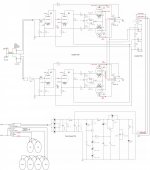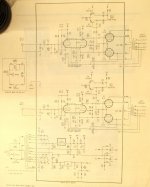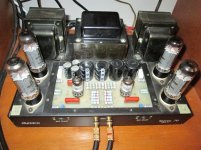I have always used the 4Ω output on my Dynaco ST-70 series ii. My speakers are 4Ω.
Why is the negative feedback always connected to an 8Ω output or even a 16Ω output on tube amps when they very often are not the outputs used? Is this why some prefer to connect 4Ω speakers to the 8Ω output?
I am building the amp with the schematic attached. Why not connect the neg feedback to the 4Ω output, and if so, what value resistor would I need to use?
I am also wondering if I should change it on my Dynaco ST-70 series ii?
Edit: updated the ST-70 ii schematic
Why is the negative feedback always connected to an 8Ω output or even a 16Ω output on tube amps when they very often are not the outputs used? Is this why some prefer to connect 4Ω speakers to the 8Ω output?
I am building the amp with the schematic attached. Why not connect the neg feedback to the 4Ω output, and if so, what value resistor would I need to use?
I am also wondering if I should change it on my Dynaco ST-70 series ii?
Edit: updated the ST-70 ii schematic
Attachments
Last edited:
Firstly R8 is to allow cathode bias voltage detection, nothing to do with the nfb loop. Too much current flowing will illuminate the LED as a warning of imminent meltdown.
You can choose whichever tapping you want for the nfb loop but you will need to recalculate the values of nfb components accordingly and in your schematic, reverse the anode wires if you select the 4 Ohm tapping, for obvious reasons.
You can choose whichever tapping you want for the nfb loop but you will need to recalculate the values of nfb components accordingly and in your schematic, reverse the anode wires if you select the 4 Ohm tapping, for obvious reasons.
Yes, I know about R8 not being the right one. 👍 As I said, I borrowed that schematic (now deleted) from another thread, and someone else added that red circle around R8. I have edited the original post and changed it to a photo of the schematic I have to avoid future confusion. 🙂 It's not easy to read, but it's the best I have. It's a photo of my 30 year old Dynaco owner manual.
Wow, I hadn't thought of that. Thanks so much. I would have totally missed that one.
Changing the Dynaco ST-70 series ii might be too complicated for me to handle. I have no idea how it would affect the LED bias indicators located on the front panel. The amp I am building now wouldn't have that complication at least.
I'm still curious about why they choose the 8Ω or even a 16Ω output for most (or all) amplifiers. I guess they assume it's the most likely to be used instead of some good reason backed by physics? That applies to all amplifiers, not just these two, so I consider this a topic of general interest.
reverse the anode wires if you select the 4 Ohm tapping, for obvious reasons.
Wow, I hadn't thought of that. Thanks so much. I would have totally missed that one.
Changing the Dynaco ST-70 series ii might be too complicated for me to handle. I have no idea how it would affect the LED bias indicators located on the front panel. The amp I am building now wouldn't have that complication at least.
I'm still curious about why they choose the 8Ω or even a 16Ω output for most (or all) amplifiers. I guess they assume it's the most likely to be used instead of some good reason backed by physics? That applies to all amplifiers, not just these two, so I consider this a topic of general interest.
Attachments
Last edited:
To answer your4 original question of why?:
My guess is that the higher the tap impedance, the higher the feedback voltage. This in turn gives a higher ratio of the feedback resistors and for a given cathode resistor, a greater selection of values for the feedback resistor to the cathode resistor. It also impacts the capacitor value in parallel with the feedback resistor.
With tighter component tolerances today (which give a lot more selections since the stadard values for each tolerance are different), I don't see an advantage.
My guess is that the higher the tap impedance, the higher the feedback voltage. This in turn gives a higher ratio of the feedback resistors and for a given cathode resistor, a greater selection of values for the feedback resistor to the cathode resistor. It also impacts the capacitor value in parallel with the feedback resistor.
With tighter component tolerances today (which give a lot more selections since the stadard values for each tolerance are different), I don't see an advantage.
The highest impedance winding typically has the best coupling and least phase shift at high frequencies, so may be easier to compensate. Resistor is easy to calculate, capacitor across it and any high frequency shelf network have to be found by experiment (best square wave, stability into various loads).
I assume that the 4 Ohm output is a tap, not a separate winding with opposite polarity as the schematic shows. As shown, half the secondary is always unused, resulting in higher leakage inductance. Hard to measure with an ohmmeter, nearly zero Ohms, but you could put 117V on the primary and measure each secondary plus the sum.
I assume that the 4 Ohm output is a tap, not a separate winding with opposite polarity as the schematic shows. As shown, half the secondary is always unused, resulting in higher leakage inductance. Hard to measure with an ohmmeter, nearly zero Ohms, but you could put 117V on the primary and measure each secondary plus the sum.
It depends on the output transformer. As Tom Bavis indicates, some OPTs exhibit better (or worse) behavior depending on the output tap selected for feedback. For instance, the Acrosound TO-330 is notoriously tough to tame due to some excessive peaks in the high-frequency response. Unless you design a multi-tap feedback network like Eico did in the HF-60, you're better off taking the feedback from the 4 ohm tap. You would need to 'scope your amp's square wave behavior to determine which tap gives you the smoothest response and the best high-frequency stability.
I would not change the ST-70 unless you're prepared to look very closely at the results on a scope. The A-470 is an excellent transformer and the feedback works best from the tap chosen by Dynaco.
I would not change the ST-70 unless you're prepared to look very closely at the results on a scope. The A-470 is an excellent transformer and the feedback works best from the tap chosen by Dynaco.
Last edited:
Unless you design a multi-tap feedback network like Eico did in the HF-60
Interesting. I looked at the schematic, and they did just that.
Although making the change from one tap to another is far too complicated for me to attempt, I do think it's an interesting question that I haven't seen addressed online. I've read over the years various experiments where people increased or decreased the negative feedback by changing a resistor or two, with varying results, but nothing about which tap engineers use and why. I have always had a crazy idea that there ought to be a negative feedback switch to allow the user to experiment with slightly more or slightly less negative feedback, but that's a different question.
It's a fairly esoteric topic, I suppose. Over at the Audiokarma tube forum, Dave Gillespie is the resident expert in this area and has posted a number of excellent threadson modifying and improving vintage tube equipment, including Heathkit, Fisher, Eico, Fairchild and others. His four lengthy threads on the early Heathkit Williamson amplifiers (the W-2, the W-3, the W-3AM and the W-4) are excellent primers on the topics of transformer quality, bandwidth, distortion, feedback and stability in tube amps. There's a sticky near the top of the tube forum listing his many interesting discussions.
https://www.audiokarma.org/forums/index.php?threads/regilding-the-gilded-lily-heaths-w-2m.767851/
https://audiokarma.org/forums/index...-frying-pan-into-the-fire-heaths-w-3m.769029/
https://www.audiokarma.org/forums/index.php?threads/heathkits-w-3am-a-new-beginning.772780/
https://audiokarma.org/forums/index.php?threads/heathkit-w4-am-modifications.459630/
https://www.audiokarma.org/forums/index.php?threads/regilding-the-gilded-lily-heaths-w-2m.767851/
https://audiokarma.org/forums/index...-frying-pan-into-the-fire-heaths-w-3m.769029/
https://www.audiokarma.org/forums/index.php?threads/heathkits-w-3am-a-new-beginning.772780/
https://audiokarma.org/forums/index.php?threads/heathkit-w4-am-modifications.459630/
Those are great links. A lot of testing done there and discussion of various taps. It takes me right back to my crazy idea that there ought to be a negative feedback switch to allow the user to experiment with slightly more or slightly less negative feedback, or even a slightly different feedback circuit, but again that's a different question. I did find some posts on forums about people totally removing negative feedback from guitar amps or occasionally making it adjustable. It probably has been offered on some stereo amplifier somewhere, I just don't know it.
There are some commercial amps today with adjustable feedback, and there were vintage ones as well, with "damping factor" controls. It's not difficult to make a adjustable-feedback amp or modify a current one.
Simple, but not always working:
As a starting point, for a properly working amplifier that uses global negative feedback,
To change the feed back from the 8 Ohm tap to the 4 Ohm tap, reduce the feedback resistor to 70% of the resistor that is used for the 8 Ohm tap.
If you have a 10kHz square wave, an 8 Ohm dummy load, and a scope, measure the square wave response into 8 Ohms on the 8 Ohm tap.
Then, change the 22k feedback resistor to 15k, and change the connection from the 8 Ohm tap to the 4 Ohm tap.
Test the square wave response again, but this time with two 8 Ohm resistors in parallel (4 Ohms), on the 4 Ohm tap.
Your Mileage May Vary, for the most part according to the output transformer.
Good Luck, and happy listening!
As a starting point, for a properly working amplifier that uses global negative feedback,
To change the feed back from the 8 Ohm tap to the 4 Ohm tap, reduce the feedback resistor to 70% of the resistor that is used for the 8 Ohm tap.
If you have a 10kHz square wave, an 8 Ohm dummy load, and a scope, measure the square wave response into 8 Ohms on the 8 Ohm tap.
Then, change the 22k feedback resistor to 15k, and change the connection from the 8 Ohm tap to the 4 Ohm tap.
Test the square wave response again, but this time with two 8 Ohm resistors in parallel (4 Ohms), on the 4 Ohm tap.
Your Mileage May Vary, for the most part according to the output transformer.
Good Luck, and happy listening!
Last edited:
I can't believe it, but I actually found a video that discusses the topic if anyone is interested. Timestamped to begin.
Interesting note: The third revision of the Dynaco ST-70 (now defunct Dynaco/Hafler by Radial Engineering) used a switch on the back of the amplifier to switch from the 8Ω to 4Ω tap instead of moving the speaker cable to different binding posts. This switch simultaneously moved the negative feedback from one tap to the other. Apparently they thought it made a significant enough difference to build that feature in.
- Home
- Amplifiers
- Tubes / Valves
- Negative feedback from 4Ω output instead of 8Ω ?


